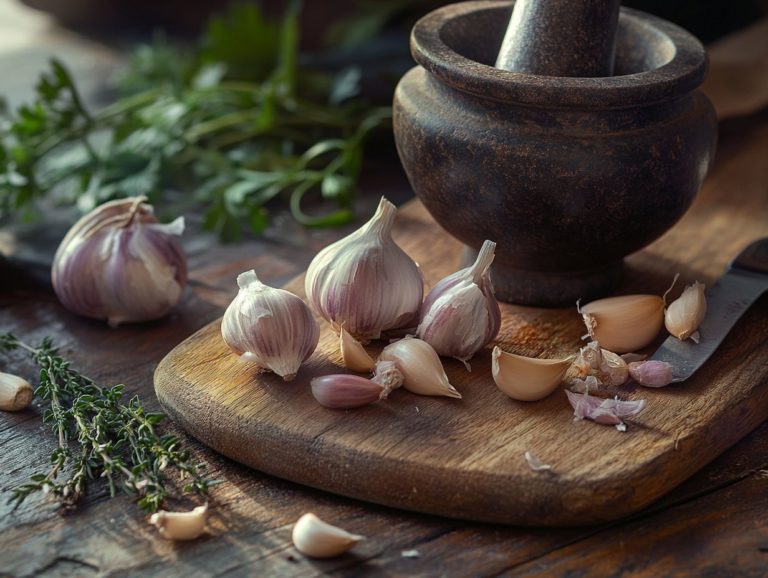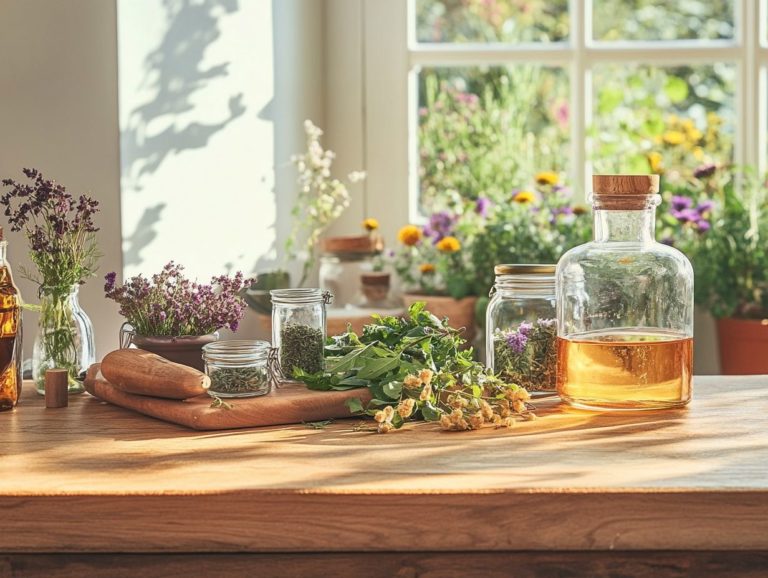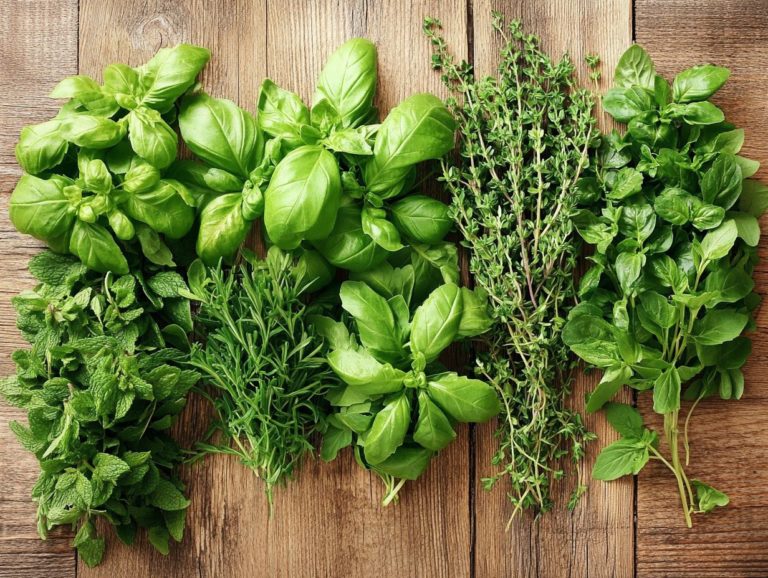How to Identify Medicinal Plants
Medicinal plants have served as nature’s pharmacy for centuries, promoting health and healing in remarkable ways. By identifying these plants, you can discover a wealth of benefits, from enhancing your wellness to accessing natural remedies that nature has to offer.
Dive into the world of common medicinal plants, exploring their uses and practical tips for recognizing them in the wild. It’s crucial to learn essential precautions to steer clear of harmful varieties, ensuring your journey is both safe and rewarding.
Consider alternative ways to acquire these powerful plants, either by buying them or growing them yourself.
Start your exciting journey into the world of medicinal plants today and unlock their incredible potential for your health.
Contents
- Key Takeaways:
- Why Identifying Medicinal Plants Matters
- Common Medicinal Plants and Their Uses
- Identifying Medicinal Plants in the Wild
- Precautions and Safety Measures
- Alternative Sources for Medicinal Plants
- Frequently Asked Questions
- What are medicinal plants?
- How can I identify medicinal plants?
- What are some physical characteristics of medicinal plants?
- Can I use technology to identify medicinal plants?
- Are there any safety precautions I should take when identifying medicinal plants?
- Why is it important to correctly identify medicinal plants?
Key Takeaways:

- Discover common medicinal plants and their health benefits.
- Learn how to identify these plants safely with the right tools.
- Explore options for purchasing or growing your own medicinal plants.
What are Medicinal Plants?
Medicinal plants are defined as species endowed with health benefits, offering essential advantages to your health and wellness through their use in both traditional and modern medicine. With a rich history that spans thousands of years and insights from esteemed figures like Michael Moore and Steve Brill, these plants hold a special place for herbalists and enthusiasts alike, especially for those curious about exploring Florida s edible and medicinal varieties.
From the ancient practices of Ayurveda in India to contemporary herbal remedies, the significance of these plants transcends cultures around the globe.
These remarkable organisms are classified based on various criteria, including their chemical constituents and the ailments they address. They range from simple chamomile teas to the powerful extracts of echinacea. Each region’s unique flora contributes to a diverse tapestry of traditional knowledge, emphasizing their cultural significance and role in community health practices.
The historical context of medicinal plants showcases how ancient civilizations relied on their properties, setting the stage for modern medicine. For anyone eager to explore further, plant identification books become invaluable resources, guiding you through the rich variety of medicinal offerings while illuminating their benefits and precautions. This effectively bridges the gap between past wisdom and present knowledge.
Why Identifying Medicinal Plants Matters
Identifying medicinal plants offers a wealth of benefits, extending beyond herbalists and plant enthusiasts to anyone eager to elevate their health and wellness through natural remedies.
By recognizing different plant species, you can tap into the health benefits of these herbal essentials, which play a vital role in traditional medicine practices.
Utilizing advanced tools like MobileNet DL, a tool used for identifying plants through images, enables you to efficiently track and comprehend these plants, paving the way for exciting developments in nutrition and herbal medicine.
Health and Wellness Benefits
The health and wellness benefits of medicinal plants are truly profound, offering invaluable support in managing various health conditions while enhancing your overall well-being through herbal remedies. These plant species have long been integral to traditional medicine systems, providing solutions for ailments that range from digestive issues to chronic pain management, all while promoting a holistic lifestyle.
Take ginger, for example. It s renowned for its ability to alleviate nausea and aid digestion, making it a go-to remedy for countless people just like you. Similarly, turmeric boasts impressive anti-inflammatory properties, frequently used to manage arthritis and boost immune function. Understanding the properties of these herbs is crucial, as it gives you the power to employ them effectively and safely.
Medicinal plants such as chamomile can help soothe anxiety and promote better sleep, offering a natural alternative to pharmaceuticals. By utilizing the strength of these remedies, you not only foster your physical health but also nurture a deeper connection to nature, highlighting the significance of holistic approaches to well-being.
Common Medicinal Plants and Their Uses

Medicinal plants are diverse. They play key roles in both traditional and modern herbal remedies.
Consider the calming effects of chamomile or the powerful anti-inflammatory properties of turmeric. These plants contribute significantly to health and wellness.
In places like Florida, with its rich biodiversity, exploring edible varieties offers a unique blend of culinary delights and medicinal advantages.
Mastering plant identification is an invaluable skill for enthusiasts and herbalists. It enhances your appreciation and understanding of nature s offerings.
Examples and Applications
Examples of medicinal plants reveal their remarkable versatility and significance in daily life and clinical settings.
Herbal allies like echinacea are celebrated for their immune-boosting properties, while aloe vera is recognized for addressing skin conditions. These plants provide tangible benefits for various ailments.
Ginger is revered for its anti-inflammatory effects and is often recommended for digestive issues and nausea. Preparing ginger tea by steeping fresh ginger slices in hot water shows how accessible these remedies can be.
Chamomile can be brewed into a soothing tea that promotes relaxation and better sleep.
Renowned herbalists, such as Rosemary Gladstar, emphasize the importance of these plants. They advocate for personal and clinical use. Modern practitioners continually investigate their efficacy, blending traditional wisdom with contemporary research to enhance health and well-being.
Identifying Medicinal Plants in the Wild
Identifying medicinal plants in the wild is rewarding. It helps you connect with nature and discover the benefits of local plants.
Foraging in regions like the Rocky Mountains offers unique insights into plant species relied upon by herbalists and indigenous communities for generations.
Using plant identification books and automated recognition tools powered by advanced technology can enhance the accuracy and efficiency of this fascinating practice.
Tools and Techniques for Identification
Utilizing the right tools for plant identification ensures accurate recognition of medicinal plants and avoids potential errors.
With advancements like MobileNet, a type of technology that helps identify plants using your mobile device, you have innovative solutions that make identification easy for both novices and seasoned herbalists.
To maximize the benefits of these tools, explore various dedicated apps for plant enthusiasts. These apps often feature rich databases of flora and user-friendly interfaces that simplify your journey.
Some well-curated books detailing regional plant species are invaluable resources, especially when you’re out in nature without internet access.
Familiarize yourself with key characteristics like leaf shape, flower color, and growth patterns to enhance your identification skills.
Engage with community knowledge through local gardening clubs or online forums. This fosters camaraderie and provides valuable insights that enrich your learning experience.
Precautions and Safety Measures

Always remember to follow safety precautions when exploring medicinal plants. This diligence helps prevent adverse effects and ensures a rewarding foraging experience.
Mastering the art of identifying toxic or harmful plants is paramount for anyone interested in herbal remedies. Misidentification could lead to serious health risks. Your journey into herbalism should always prioritize safety and knowledge.
Avoiding Toxic or Harmful Plants
Avoiding toxic or harmful plants is essential for your plant identification and foraging activities. This ensures you can safely enjoy the benefits of herbal remedies without jeopardizing your health.
Many seemingly benign plant species can harbor potent toxins that pose serious risks for those who are untrained in identifying them. Take, for example, the enticing allure of the Foxglove plant (Digitalis purpurea). Its beauty might deceive even the most cautious forager. However, its leaves contain compounds that can dangerously impact heart function.
Similarly, the vibrant red berries of the Jerusalem Cherry (Solanum pseudocapsicum) can be tempting, but they are harmful if eaten, as consuming them can lead to severe gastrointestinal distress.
And let s not overlook the delicate, fern-like fronds of the Poison Hemlock (Conium maculatum). While they may appear innocent, they conceal natural substances that can be toxic.
Given these dangers, stay safe by being cautious! Always check trusted resources or seek expert advice whenever you’re unsure about a plant’s safety. Your well-being depends on it.
Alternative Sources for Medicinal Plants
Exploring alternative sources for medicinal plants significantly enriches the accessibility and variety of herbal remedies at your fingertips. Whether you choose to purchase from reputable suppliers or cultivate your own herbal plants in a home garden, you can secure a steady supply of high-quality, fresh medicinal options.
This proactive approach not only elevates your herbal practice but also gives you the power to craft personalized remedies that resonate with your unique needs.
Purchasing or Growing Your Own
Whether you re purchasing or cultivating your own medicinal plants, grasping the best practices for each option can profoundly influence the quality of the herbal remedies you create.
Sourcing plants from reputable suppliers guarantees potency, while nurturing a home garden fosters a personal connection that allows you to tailor care according to your preferences.
Each path presents its unique advantages and challenges. When you buy from trusted suppliers, you typically gain access to a diverse array of well-established species, complete with assurances of quality, though this often comes with a premium price tag.
Conversely, growing your own plants can be incredibly fulfilling and cost-effective, but it demands time, knowledge of local growing conditions, and diligent maintenance.
You ll need to consider factors like light, soil type, and water requirements for various species, as these elements significantly impact their health and potency.
By researching reliable suppliers and understanding the specific care needs of each plant, you can enhance your chances of successful cultivation and achieve beneficial herbal outcomes.
Frequently Asked Questions

What are medicinal plants?
Medicinal plants are plants that have been traditionally used for medicinal purposes due to their healing properties. They contain chemical compounds that have therapeutic effects on the body.
How can I identify medicinal plants?
There are several ways to identify medicinal plants, including looking at their physical characteristics, researching their traditional uses, and consulting with an expert in the field.
What are some physical characteristics of medicinal plants?
Medicinal plants can have distinct features such as specific leaf shapes, unique colors and patterns, or strong aromas. These characteristics can help differentiate them from other plants.
Can I use technology to identify medicinal plants?
Yes, there are various apps and online resources available that use image recognition technology to help identify medicinal plants. These can be helpful for beginners or when trying to identify a specific plant.
Are there any safety precautions I should take when identifying medicinal plants?
Yes, it is important to always be cautious when handling and consuming any plants, especially if you are not familiar with them. It is best to consult with an expert or do thorough research before using any plant for medicinal purposes.
Why is it important to correctly identify medicinal plants?
Correctly identifying medicinal plants is crucial for your safety. The right plant ensures effectiveness and health benefits.
Using the wrong plant can lead to harmful side effects. Always confirm your identification before use. Don’t risk your well-being; double-check your sources!





